Nonprofit Strategic Planning: Ultimate Guide + Free Template



Nonprofit strategic planning can help your organization meet challenges effectively and take advantage of new opportunities. Despite the many benefits that strategic planning can bring, 49 percent of nonprofits lack a strategic plan.
Organizations that do have a strategic plan continually express the advantages that this type of preparation gives them. One study found that 86 percent of respondents believed that having a strategic plan positively impacted revenue generation through grants, donors, events and other avenues.
Whether you’re starting a new nonprofit, crafting an emergency plan to react to unexpected external circumstances, or creating your strategy for the next two to five years, this guide will help your nonprofit get the most out of its strategic plan. We’ll cover:
Annual strategic planning is the key to unlocking your growth potential for the future. Let’s get started.
Nonprofit strategic planning is the process of creating a blueprint that guides an organization for a specified time period and helps accomplish its goals. The strategic planning process involves reflecting on your mission to identify your most important goals and determining the strategies you’ll use to reach them.
A good strategic plan ensures you have charted the necessary pathways to meet (and hopefully exceed) your organization’s goals.
Ideally, every three to five years, your board and staff directors will meet to realign goals and begin the strategic planning process. This plan is a living blueprint based on everyone’s ideas.
When it comes to strategic planning, there are a few common hesitations that nonprofits voice throughout the process. Here are three misconceptions about the process:
Learn more about common strategic planning misconceptions in this Bloomerang webinar:
You’ll discuss measurable objectives for the team to reach and draft the priorities for each of these objectives. You may begin with a SWOT (strengths, weaknesses, opportunities, threats) analysis. This can help you start defining goals and considering which strategic planning model will best work for your organization.
Different circumstances and goals will require different types of nonprofit strategic plans. Choose a strategic planning model based on your nonprofit’s current circumstances, opportunities and threats.
Carefully examine the following strategic model plans to decide which one will best suit your nonprofit’s needs:
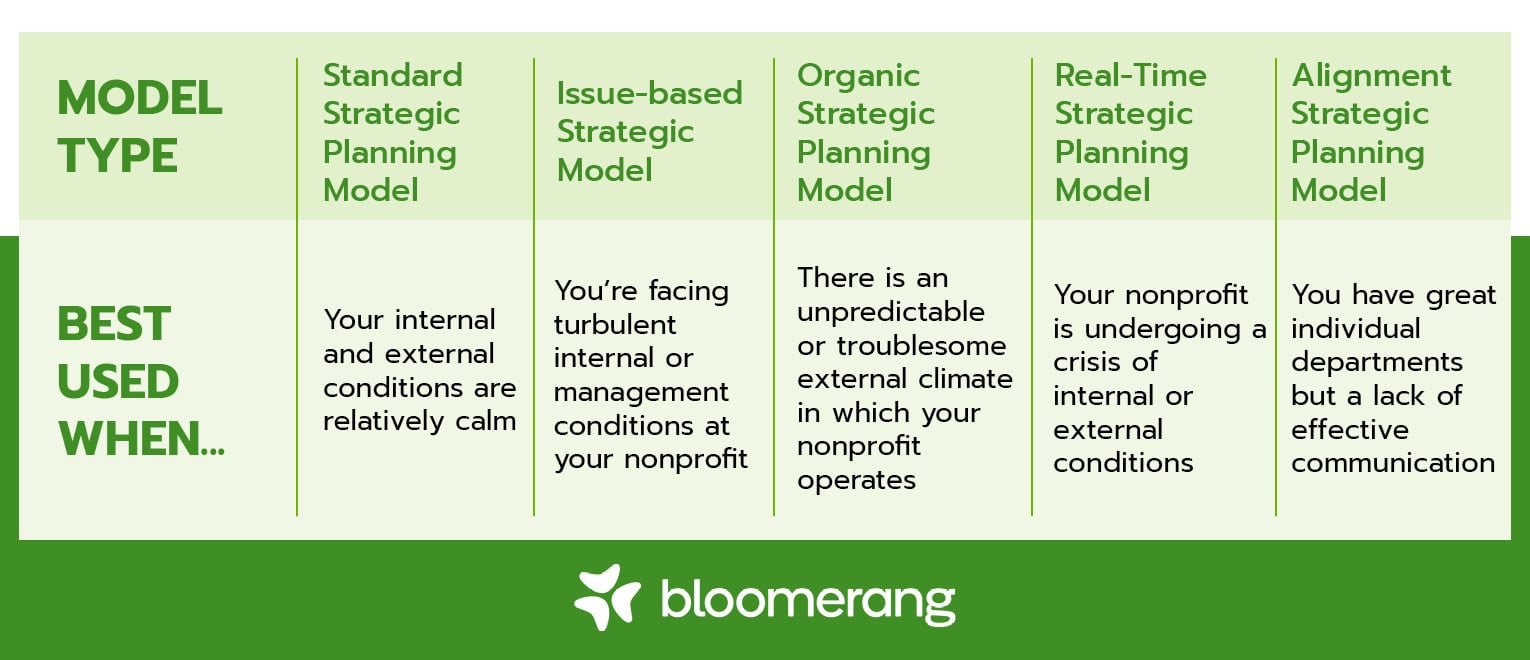
The standard strategic planning model, also known as the basic planning model, vision-based model, goals-based model or conventional model, is the most common nonprofit strategic planning model.
It’s best to use this model when your organization’s external surroundings are generally calm. When you start using this model, the economy is probably stable, your community and country are at peace and your organization is well-established in the community.
Generally, this model follows these steps:
Here’s an example of what this would look like: Let’s say your organization is an animal shelter. In the next year, your specific short-term goal is to increase the shelter’s capacity by 50 animals and invest in the materials to do so.
To do this, your organization will need to increase fundraising revenue by $10,000 by finding new outreach opportunities and strengthening relationships with existing supporters to increase donor retention.
You may decide to ask one team member to post to social media every day to engage your online audience. Meanwhile, you may assign another person to call new donors to thank them and increase your new donor retention.
This model is the most common because the climate in which your organization resides is, more often than not, fairly stable. When it does become unstable, that means it’s time to switch to a different model.
An issues-based strategic planning model can be used when your organization’s internal operations are in more turbulent conditions. For example, if you’re undergoing frequent staff turnover, a change in leadership or are understaffed, you may find an issues-based strategic planning model to be the best choice.
This nonprofit strategic planning model helps organizations get back on track if they have strayed from the path to success.
To implement this strategic planning model, complete the following tasks:
Consider the following scenario: Your nonprofit has limited staff and struggles to increase fundraising revenue. You may decide to address this by working with an external fundraising consultant or directing your staff’s attention to building relationships with your most engaged donors who are likely to increase their giving amounts.
An issues-based nonprofit strategic planning model is a living plan. Instead of setting it in stone, set check-in milestones and make adjustments based on your progress and results.
The organic or nonlinear nonprofit strategic planning model is best when there are uncertain external factors that threaten your nonprofit’s situation.
Using this model, your team members will come together to solidify their understanding of the organization’s mission and goals. Each person then comes up with actionable next steps to help get closer to that goal by the next time the group meets.
Generally, putting this model into practice looks something like this:
For instance, you may find that one team member, Theo, is especially good at face-to-face communication on the retreat. He’s empathetic and understanding and would be a great candidate for holding meetings with major donors to build relationships with them. He may have a goal to leverage the information in your new donor database to foster relationships and grow major giving by 10% in the coming year.
This model never looks the same for two organizations. Each team member has inherent strengths, so this model is designed to help your nonprofit make the most of your unique strengths.
The real-time nonprofit strategic planning model is useful when your nonprofit is in the midst of a crisis, like an economic recession or national/global catastrophe. The situation could also be limited to your organization. For instance, you might have been the victim of a cyberattack or your headquarters might have been severely damaged in a tornado.
This model relies on an extreme focus on short-term goals that aim to help you weather the storm. Your nonprofit staff members might meet as frequently as every week to discuss your progress toward these short-term goals. The model usually looks like this:
Consider the following situation: You discover that your nonprofit was the victim of a cyberattack that potentially left some donors’ information at risk. In response, you meet with your team to define and align on urgent next steps.
You assign several team members to assess the extent of the attack and summarize their findings into a clear report. Then, you designate other team members to notify impacted donors as quickly as possible about the breach. You outline the steps you’ll take to keep donors’ information more secure in the future and prevent future attacks.
As you can see, these goals are small and manageable in a short time. Goals are created as responses to the direct impact that external forces have on your organization’s internal operations.
The alignment nonprofit strategic planning model is best when your organization has great individual departments or team members but has trouble when it comes to communication between these departments.
This model tends to look something like this:
For instance, say your organization has an incredible grant writer, an excellent executive director, a communicative and empathetic major gift officer and very capable fundraisers. However, they have trouble communicating with one another about the nonprofit’s goals and what each of them is doing to reach those goals. The result is discord among teams and a lack of progress.
In this case, consider ways to encourage teamwork between members. You may provide an overall fundraising goal for your fundraisers and major gift officer to work on together. Or, you may set up check-in meetings for everyone to meet with the executive director and ensure that the director knows what’s happening in each department and can prioritize their tasks accordingly.
The alignment nonprofit strategic planning model is a great way to set new communication standards and processes to incorporate moving forward as a team.
Before you dive into the strategic planning process, it can be helpful to know what type of plan or report you’re going to end up with. Generally, strategic planning forms look similar to this:
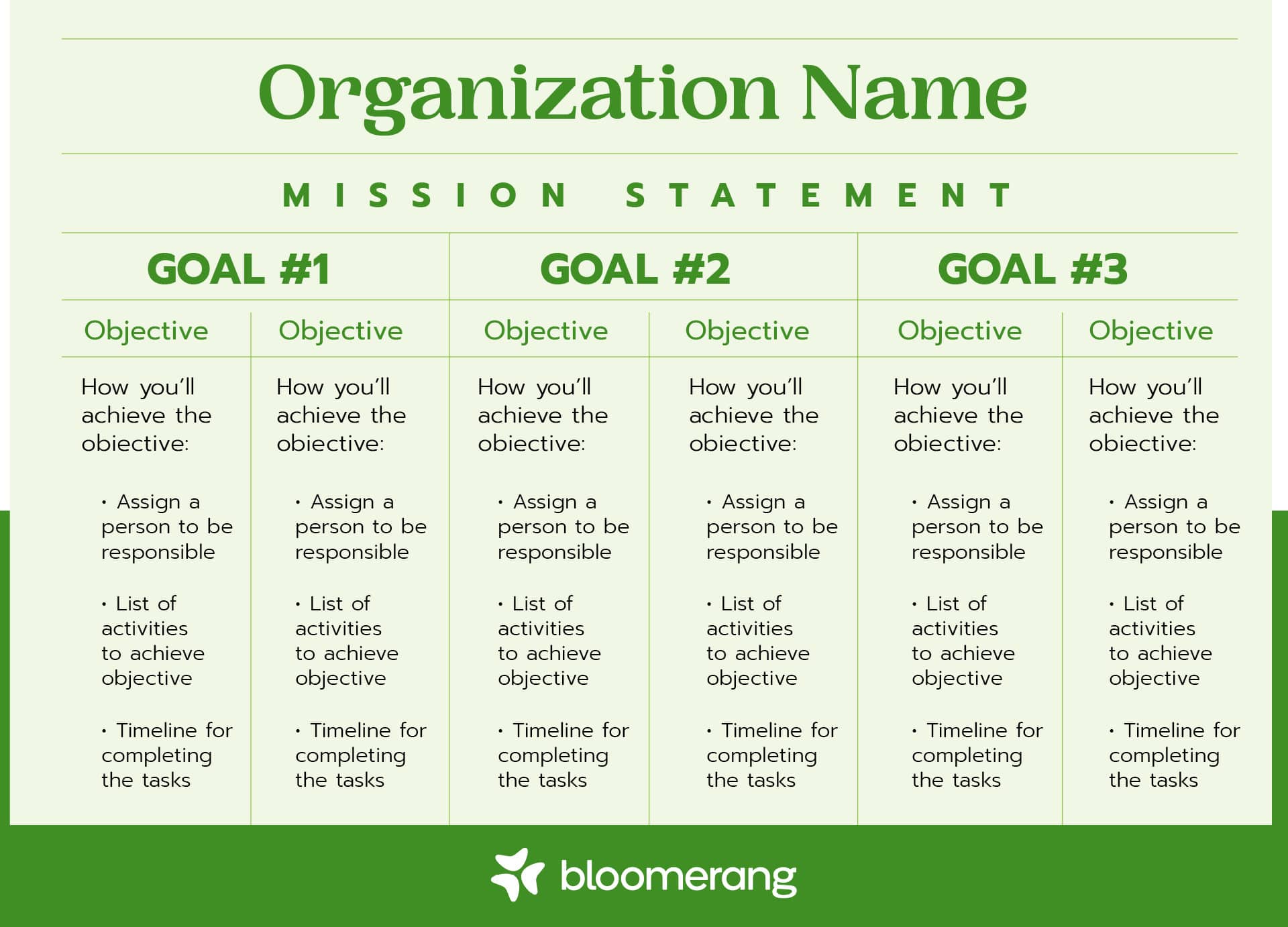
This template outlines all of the essential planning steps that we’ll review in the next section. Here is a high-level overview of what your plan should include:
Let’s take a closer look at how to develop each aspect of your strategic plan.
Use these steps to launch the strategic planning process:
Use your organization’s budget to determine generally how much you need to raise to achieve your philanthropic goals. Then, outline the strategies you’ll use to acquire that funding.
For example, you may decide to raise:
Every nonprofit will have a different breakdown of their fundraising goals based on their current fundraising initiatives and their community’s giving capacity.
Next, ask your stakeholders for input about your fundraising goals. Provide context for your goals and philanthropic objectives, explain how each will impact your mission, then ask for feedback about the plan.
The different stakeholders you should reach out to include:
Running the plan by everyone will help you make sure that the goals you’ve set are achievable and manageable for your team.
Stakeholders might raise the alarm if your fundraising amount is drastically different from last year or if you’re relying on strategies that have been ineffective in the past.
For example, let’s say your nonprofit has a good track record with grant writing. You’ve won 80% of the grants you’ve applied for, so you decide to dedicate a large portion of your fundraising revenue plan to be raised using grant money. Seems reasonable, right?
Well, your grant writer may bring up the valid point that you’ve only been that successful because you’re incredibly picky about the type of grant you apply for. While the percentage looks impressive, there aren’t enough grants out there to meet the goal you’ve set. This is great insight and enables you to switch up your strategy to be as successful as possible.
You may consider doing a SWOT (strengths, weaknesses, opportunities, threats) analysis of your past fundraising to better understand what areas you’re already strong in and what could be improved.
This chart can help you outline your strengths, weaknesses, opportunities and threats clearly and concisely:

Some of the fundraising and marketing strategies your organization should take into consideration include:
Assign areas that need improvement a lower fundraising target than the aspects of your strategy where you already know you’re strong. This way, you can try out different strategies to make these elements stronger without as much pressure.
For example, if you know your nonprofit has an incredible major giving program, specify that a larger portion of your fundraising will likely come from this avenue. If you know that you could use improvement on your new donor retention rates, you might set that at a lower goal and use this as an opportunity to try out new things like calling new donors and setting up a welcome email series.
When you set your fundraising goals, make sure they’re SMART:
For example, let’s say you have a specific goal for increasing individual contributions to your annual fund.
Here are a few examples of SMART goals that target this objective:
These goals include specific numbers and time frames to help orient your strategic planning around quantifiable metrics.
Use reporting tools in your donor management system and marketing platforms to help keep your team accountable for reaching your goals.
Assign each team member an individual role that they’re responsible for. Here’s an example of a chart that clearly defines each activity, the staff member accountable for the task and the deadline:
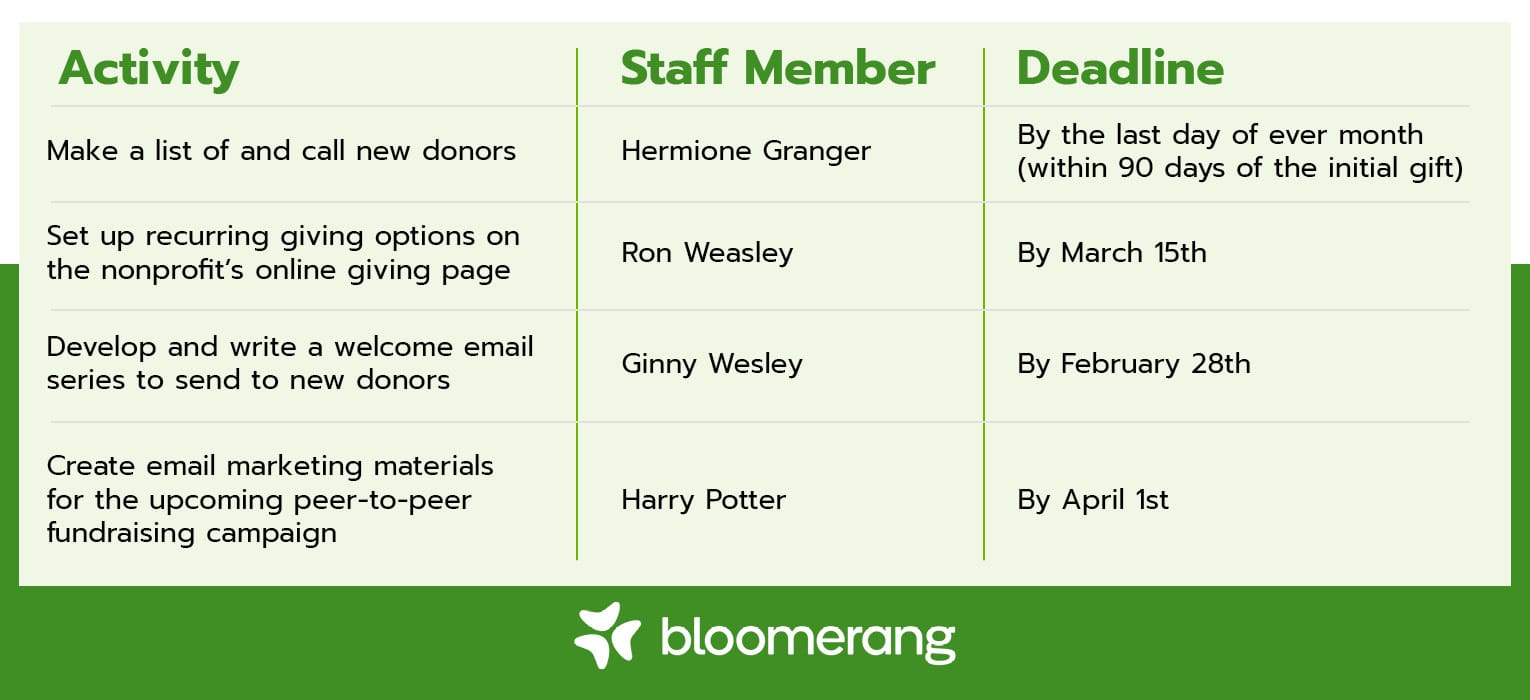
When everyone is clearly aware of their role at the organization and how their actions will impact the mission at large, you’ll make sure everything gets done. Plus, everyone will have a sense of purpose as a part of the team.
In addition to assigning team member roles, you can also automate certain processes to free up more staff time. For example, if you used to send out the monthly newsletter manually or personally manage every social media post, consider investing in new marketing software as part of your strategic plan.
Ask yourself some of the following questions.
Sometimes the answer to these questions leads you to invest in new nonprofit software like a new CRM to automate donor engagement efforts or volunteer management tools to streamline volunteer scheduling.
Here are links to some strategic plans from other nonprofit organizations for you to analyze and consider while you plan your own:
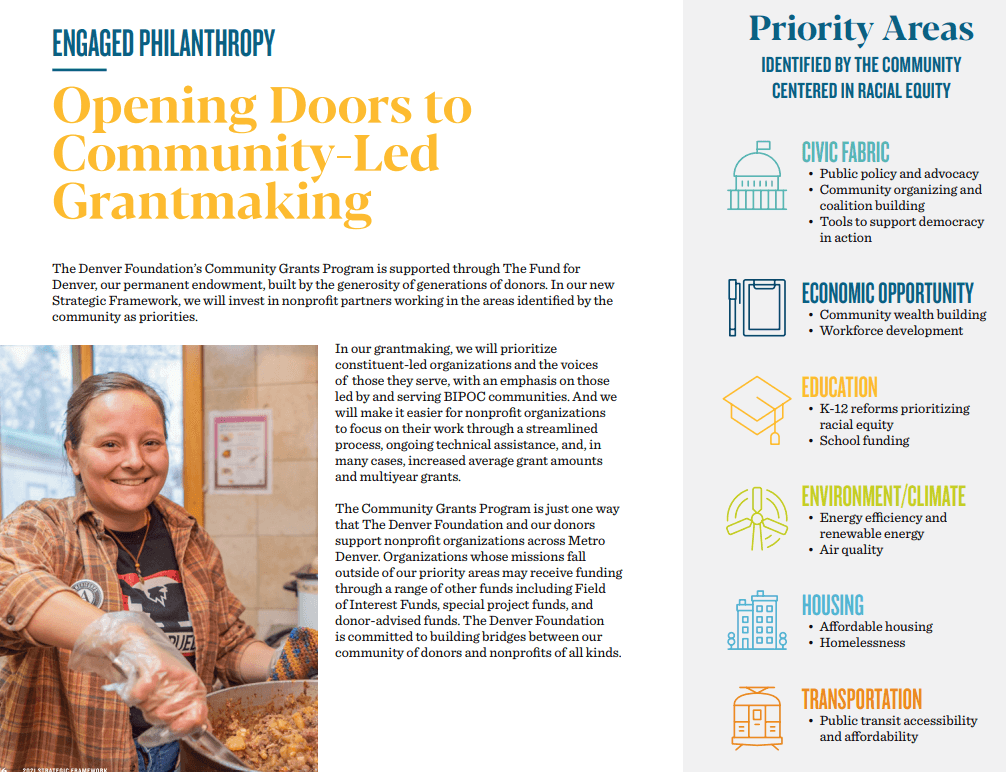
The Denver Foundation is a community nonprofit foundation committed to strengthening the Metro Denver area.
The organization’s 2021 strategic framework was written to provide guidance for a decade — a longer period than a typical strategic plan. This extended time frame means the document is intended to be a living, flexible blueprint that will evolve as the community’s needs change.
The strategic plan is outlined in a user-friendly online booklet that clearly displays the organization’s mission, vision, purpose and values. It also details new policies, such as a new donor management approach, priority service areas and the organization’s business model.
This represents an example of a more far-reaching plan that will help the organization develop a long-term approach to reaching its mission.
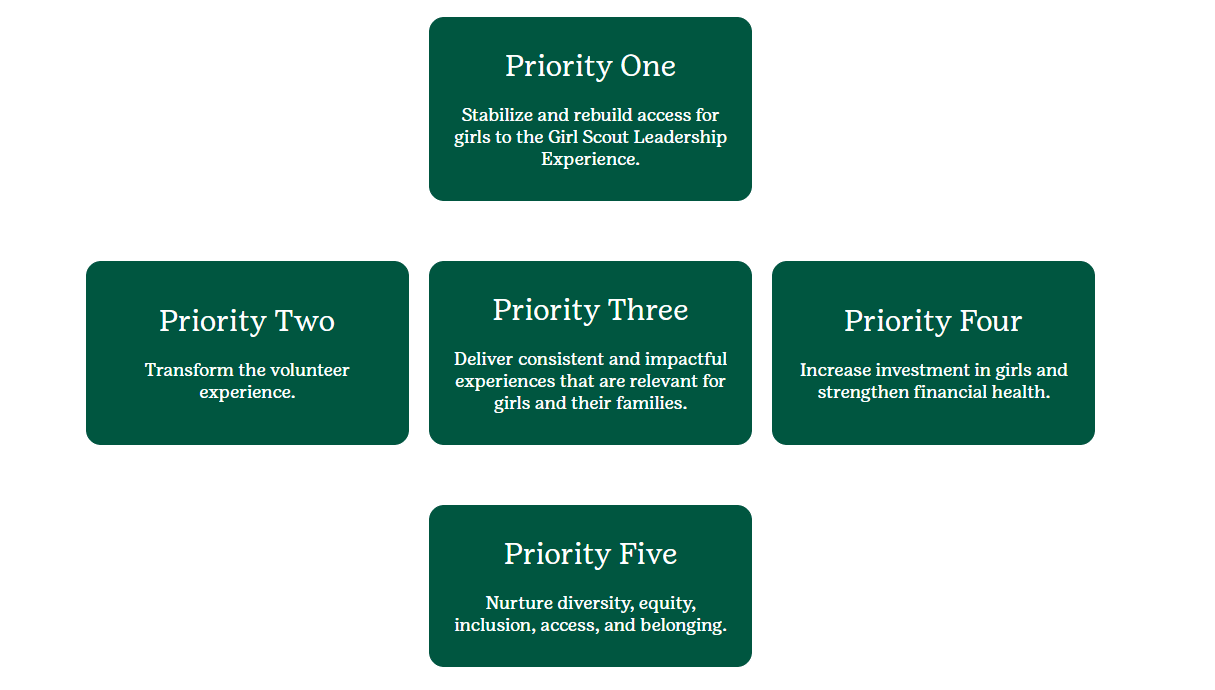
The Girl Scouts organization provides programming and leadership training for girls in communities across the country and worldwide.
Girl Scouts of Greater Los Angeles outlined a strategic plan for 2022-2023. On the online web page, the organization points out five strategic priorities. This helps interested readers get a quick overview of the organization’s most important plans before diving into the full report.
In the complete plan, each priority also includes information about specific initiatives to support the goal and the intended outcome of each objective. This helps audience members understand the actions they should expect to see from the organization over the coming months.
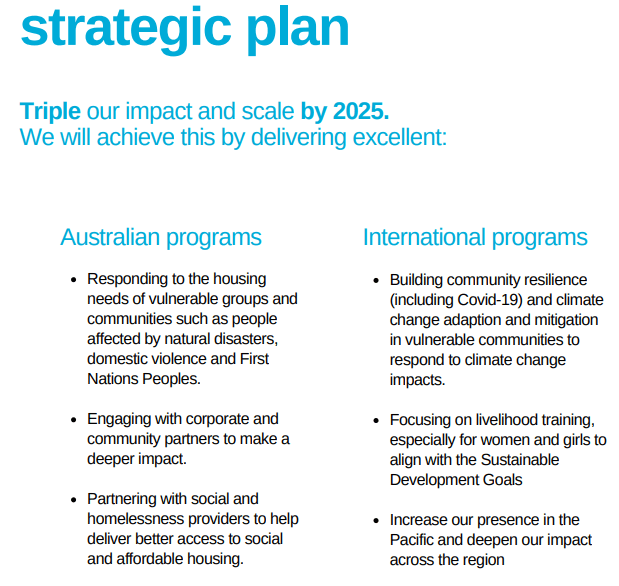
Habitat for Humanity’s mission is to provide affordable housing to families in need around the globe.
The organization’s Australian branch published a strategic plan for 2021-2024 that aligns a vision for the country’s programs with the organization’s overarching international activities.
The plan also includes a visually-engaging strategic pyramid that depicts how the strategic plan fits into Habitat for Humanity’s purpose, mission, vision and principles. This can help readers visualize how each element of the strategic plan is like a puzzle piece that helps build the full picture of the organization’s efforts.
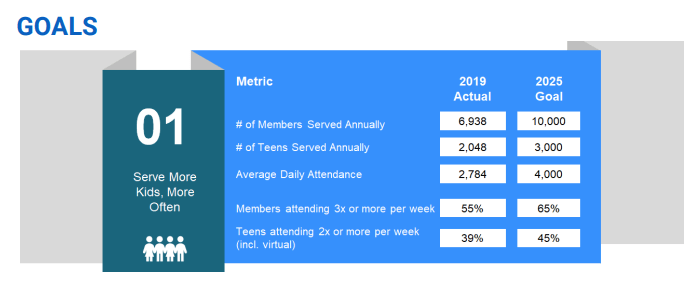
Boys & Girls Club of America is dedicated to providing enriching after-school programs for kids and teens. The Metro Atlanta chapter’s 2021-2025 strategic plan outlines plans to reach more kids, grow their supporter base and improve diversity and inclusion.
The plan includes five main focus areas, each with a few specific objectives, along with specific quantifiable goals. The plan also incorporates a timeline chart depicting when each goal is projected to be completed.
This level of specificity is essential for staying on target and reaching goals effectively.

The Substance Abuse and Mental Health Services Administration (SAMHSA) is a U.S. government agency established to make mental health and substance abuse help and resources more readily available.
The organization’s 2023-2026 strategic plan is oriented around four guiding principles: equity, trauma-informed approaches, commitment to data and evidence and recovery.
The plan includes plenty of data and research to explain why each principle was chosen. It also highlights five priorities for this three-year period that will help bring each principle to life.

The Nature Conservancy’s mission is to promote worldwide conservation efforts. The Pennsylvania and Delaware Chapter released a strategic plan for 2022-2024 that illustrates how the chapter will take local actions to support the overarching mission.
The plan is organized into sections based on strategic priority or geographic location. Critically, it includes information about how the chapter will scale up its conservation efforts and how donors, partners and volunteers can support each effort. This brings supporters into the conversation and helps them envision the steps they can take to have an impact on the mission.

UNICEF is a United Nations Agency devoted to providing humanitarian aid to children worldwide.
The 2022-2025 strategic plan starts with an informational overview of the progress that has been made along with challenges that children face around the world. Next, the plan details strategic shifts that the organization is currently taking, along with five goal areas.
The plan ends with a detailed roadmap chart of each principle and objective and the target completion dates.
Donor management and fundraising software can offer plenty of support throughout your entire strategic planning process. Here are just a few of the ways you can use integrated donor management and fundraising software to streamline your planning:
Interested in seeing what these activities look like in practice? Schedule a Bloomerang demo today for a personalized look at how our nonprofit software solutions can support your organization’s strategic plan.
Don’t just check off the “strategic plan” box for your nonprofit. Instead, use the information and resources in this guide to create a comprehensive and valuable plan that you’ll use to grow your organization.
Want to learn more about effective planning and nonprofit management? Check out these additional resources:

Comments
Mmamakgala Lefalatsa
Washington
OFH Soup Kitchen
Andrea Shirey
Eduardo Policarpio
Katherine Silvas